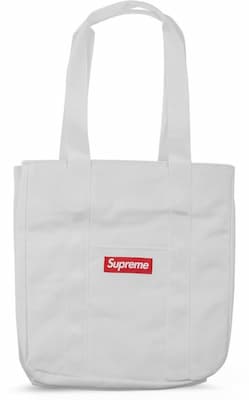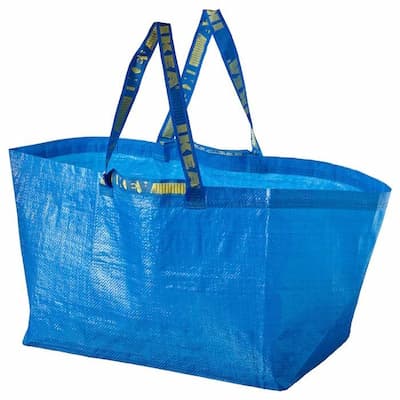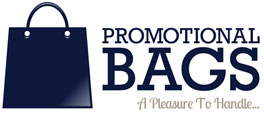
12 October, 2023
Tote to Trend: Evolution of Promotional Bags in the Fashion Industry
In the intricate dance between fashion and functionality, promotional bags have found their rhythm. Historically viewed as simple tools for marketing, these bags have evolved, carving out a significant niche in the vast realm of fashion. By blending aesthetics with brand messaging, several iconic brands have successfully transformed their promotional totes into must-have accessories. Let's look at a few.
1. Supreme's Red Box Logo Tote Bag

Few brands in the streetwear domain have managed to achieve the cult status that Supreme enjoys. With its roots deep in New York's skate culture, the brand has effectively merged rebelliousness with luxury. At the heart of this intersection stands the iconic red box logo, a symbol as straightforward as it is powerful. The story of the Red Box Logo Tote is an interesting one. On the surface, it's a simple white tote bag emblazoned with the brand's emblematic logo. However, the journey of this tote from a promotional accessory to a fashion statement is a testament to Supreme's branding genius.
When these totes were initially introduced, they were promotional items—freebies offered to customers with their purchases. A smart move, considering it's a walking advertisement. But the brand's immense street credibility and the tote's minimalist design made it an overnight sensation.
Supreme has always operated on the principle of scarcity. Limited product releases create a frenzy among fans, leading to long queues outside their stores and inflated prices on resale platforms. Being a free accessory, the tote became a symbol of one's successful procurement of a Supreme item, further adding to its allure. While the tote's primary purpose was for carrying items, it soon transcended its functional role. It became a canvas of expression, a representation of urban chic. In cities like Tokyo, Paris, and Los Angeles, the sight of a pedestrian, skateboarder, or influencer donning the tote became commonplace.
Their collaborative ventures with other fashion houses and artists have always garnered attention. Over time, different renditions of the tote were released, each amplifying its iconic status. Whether it was a change in material, a play with colours, or integrating art, the Red Box Logo Tote remained central to these innovations. In contemporary fashion culture, accessories often speak louder than clothing. They're markers of taste, brand loyalty, and sometimes, socio-economic status. Despite its promotional origins, Supreme's tote has firmly established itself in this echelon. From being featured in street-style photographs during Fashion Weeks to being a backdrop in countless Instagram pictures, its omnipresence is undeniable.
2. IKEA's FRAKTA Bag

In the vast retail landscape, certain items acquire a status that transcends their original purpose. Such is the story of IKEA's FRAKTA bag. Recognised by its blue hue and durable polypropylene material, this shopping bag, designed for carting home flat-pack furniture and Swedish meatballs, took an unexpected turn in the spotlight, thanks to the luxury fashion world.
The intrigue began when Balenciaga, a fashion house renowned for its avant-garde designs and four-figure price tags, released a tote that bore an uncanny resemblance to IKEA's utilitarian bag. With its similar blue shade, size, and double-handle design, the Balenciaga version, priced at a staggering $2,145, was in stark contrast to FRAKTA's humble 99-cent price tag.
Rather than taking offense, IKEA embraced the moment with a sense of humour. They released a cheeky ad giving instructions on identifying an "original" IKEA FRAKTA bag, highlighting its ability to rinse clean and carry hockey gear among other things. This playful take on what could have been a contentious issue showcased IKEA's brand personality brilliantly. Following Balenciaga's unintentional nod, the FRAKTA bag became an unexpected symbol of fashion's blurred lines between luxury and functionality. DIY enthusiasts and fashion influencers started repurposing the bag into various fashion items like hats, shoes, and even jackets. The once-simple storage solution was now gracing fashion blogs and Instagram feeds, amplifying its presence more than any marketing campaign might have.
The FRAKTA bag's rise to pop-culture stardom serves as a reminder of the unpredictable trajectories that promotional items can take. Its journey from being a store essential to a fashion statement highlighted the inherent potential of everyday items. Beyond its practicality, the bag began symbolising a bridge between mass-market retail and luxury, between functionality and opulence.
3. Anya Hindmarch's 'I'm NOT a Plastic Bag'

The early 2000s witnessed a growing concern about the environmental damage caused by single-use plastics. As sustainability and eco-consciousness became a priority, few could have predicted that this global conversation would intertwine so seamlessly with the world of high fashion. Enter the "I'm NOT a Plastic Bag" tote, a brainchild of British designer Anya Hindmarch.
At its core, the "I'm NOT a Plastic Bag" tote was more than just a fashion accessory; it was a statement piece. Its simple yet powerful message was a clear response to the overwhelming usage of disposable plastic bags. By sporting this tote, users weren't just making a fashion statement but were also conveying their stance on an important global issue. In a strategic move, Hindmarch collaborated with the supermarket chain Sainsbury's to sell the bags. Priced at a modest £5, it became accessible to the average shopper, not just the luxury market that typically catered to designer products. The bag's accessibility, strong message, and stylish design created a surge in demand.
The bag's release wasn't just successful; it was phenomenal. Shoppers queued overnight, reminiscent of scenes typically seen during Black Friday sales or the launch of a new tech gadget. The bags flew off the shelves in mere hours, and their limited availability further fuelled the hype. The demand was so high that enterprising individuals started reselling the bags on eBay, often at prices manifold higher than its original cost.
Hindmarch's campaign perfectly blended timely messaging, accessible pricing, and impeccable design. By aligning with a pressing global issue, she made sustainability fashionable and used fashion as a platform to amplify the conversation about eco-friendly choices. The "I'm NOT a Plastic Bag" tote symbolised a generation's aspiration to make responsible choices without compromising style.
4. Stella McCartney's Eco-Friendly Totes for Comic Relief

Stella McCartney's eco-friendly totes for Comic Relief struck a resonant chord in the bustling intersection of fashion, philanthropy, and environmental consciousness. These weren't just bags; they were emblematic of a new age of consumerism, where each purchase holds meaning beyond mere aesthetics or brand loyalty.
Stella McCartney, already a fashion tour de force, carries the unique legacy of her father, Paul McCartney, and the timeless allure of the Beatles. When she incorporated their images into her designs for these totes, it was a masterful merge of pop culture and high fashion. The Beatles' historical significance and universal appeal, combined with Stella's modern design sensibilities, made these bags instant classics. While McCartney's design credentials alone could have sold any product, she went a step further. In line with her brand's ethos, the totes were eco-friendly, appealing to an audience increasingly concerned about the environmental footprint of their purchases. For the discerning consumer, these bags were not just fashion accessories but statements of intent, symbolising a commitment to the planet.
Partnering with Comic Relief, a British charity with a formidable reputation, was a strategic masterstroke. Comic Relief's Red Nose Day campaigns have historically captured UK's imagination, and Stella's tote bags were no exception. The bags were sold almost immediately in TK Maxx stores and demonstrated the immense power of aligning a product with a charitable cause.
The success of the totes was multifaceted. On one hand, they raised significant funds and awareness for Comic Relief. On the other, they highlighted the potential for sustainable fashion products in the mainstream market. Most importantly, they underscored a paradigm shift in consumer behaviour — the demand for products that offer both style and substance, and the value of aligning oneself with causes bigger than individual gain. Her eco-friendly totes for Comic Relief were more than just bags; they were a phenomenon. They epitomised the potential of melding celebrity allure with conscious consumerism and charitable causes. While primarily a fundraising campaign, this initiative inadvertently showcased a blueprint for future collaborations, proving that when fashion meets philanthropy, the impact can be both stylish and substantial.
5. Lululemon's Reusable Bags with Inspirational Quotes

Regarding brand promotions, sometimes the most understated gestures leave the most lasting impressions. This was exactly the case with Lululemon's innovative approach to their reusable bags. Rather than using them as mere vessels to transport their products, the athletic apparel retailer saw an opportunity to extend its brand philosophy beyond the confines of its stores.
At first glance, the bags might appear like any other promotional item. However, a closer look reveals carefully curated inspirational quotes. These aren't just motivational mantras for a workout session; they're reflections of life, aspirations, and the relentless pursuit of betterment. They speak not just to the athlete but to the human spirit in all of us, urging us to push boundaries in the gym or life.
These reusable bags, stamped with motivational messages, soon took on their own life. They were no longer limited to the domain of sweaty gym sessions. Instead, they became fashion-forward staples, spotted at cafes where they held laptops or books, in offices as lunch bags, and on campuses carrying study materials. In a world where everyone was searching for daily inspiration, these bags offered it in spades. Lululemon, through these bags, achieved a unique blend of utility and branding. Every time someone carried the bag, they showcased the Lululemon brand and became ambassadors of its ethos. It was a masterstroke in subtle yet effective marketing—making brand advocates out of everyday customers.
Lululemon's initiative with its reusable bags stands as a testament to the power of intuitive branding. Combining their brand message with a universally relatable and daily used item created a ripple in the marketing realm, emphasising the profound impact of thoughtful promotional strategies.
Final Comment
These stories underscore a paradigm shift. Brands, whether intentionally or not, are realising that promotional bags aren't just passive carriers of logos. With creativity and strategic design, they can metamorphose into powerful fashion statements, commanding attention on runways, streets, and even in the annals of viral internet trends. The humble promotional bag, it seems, has truly arrived on the fashion scene.
The Promotional Bags Team

